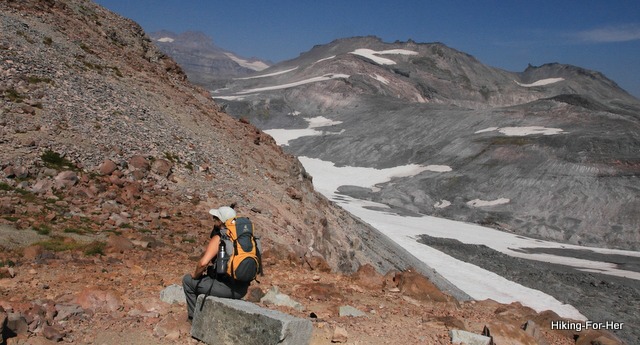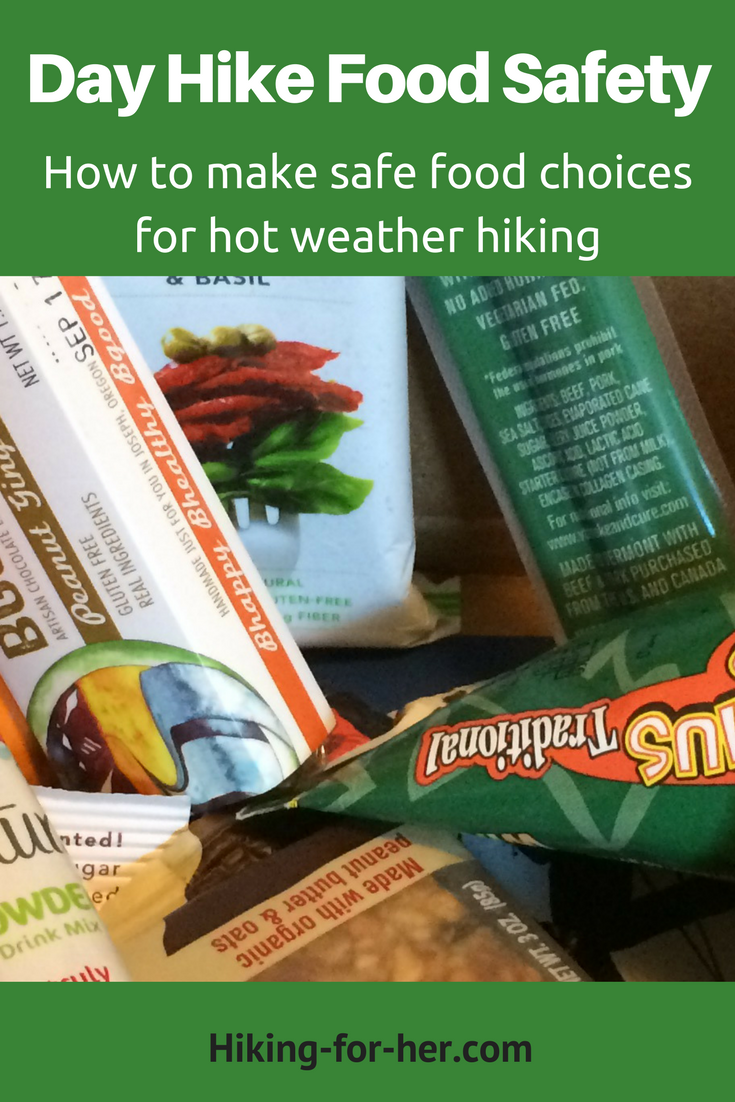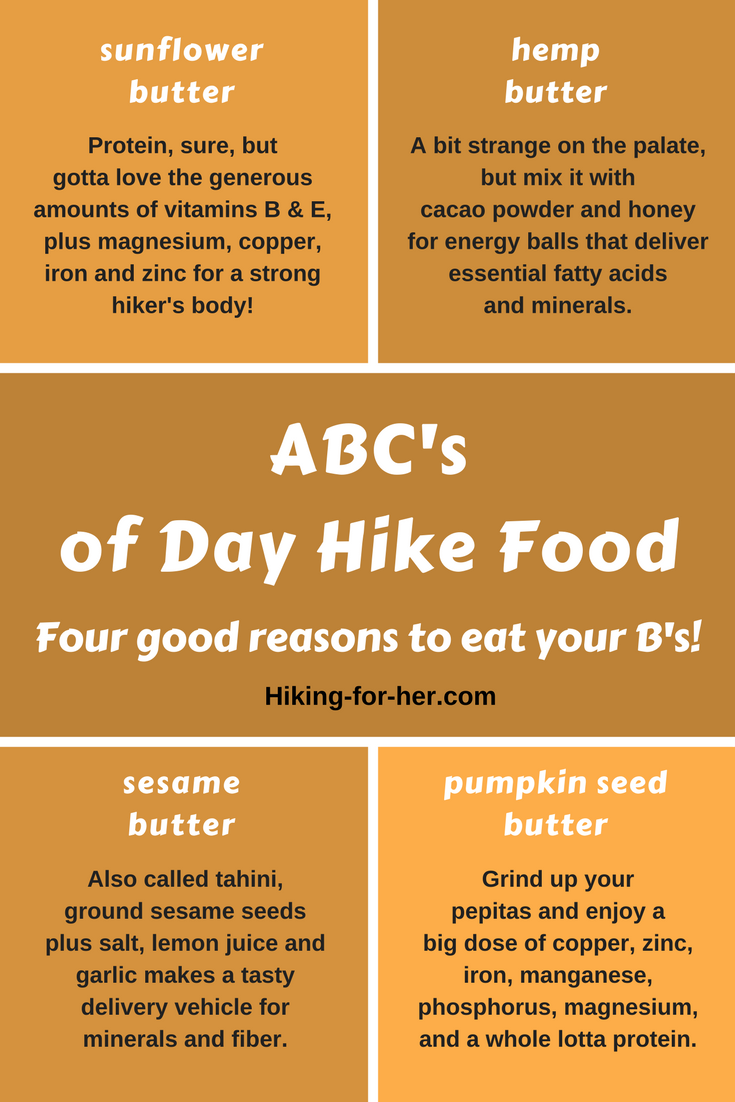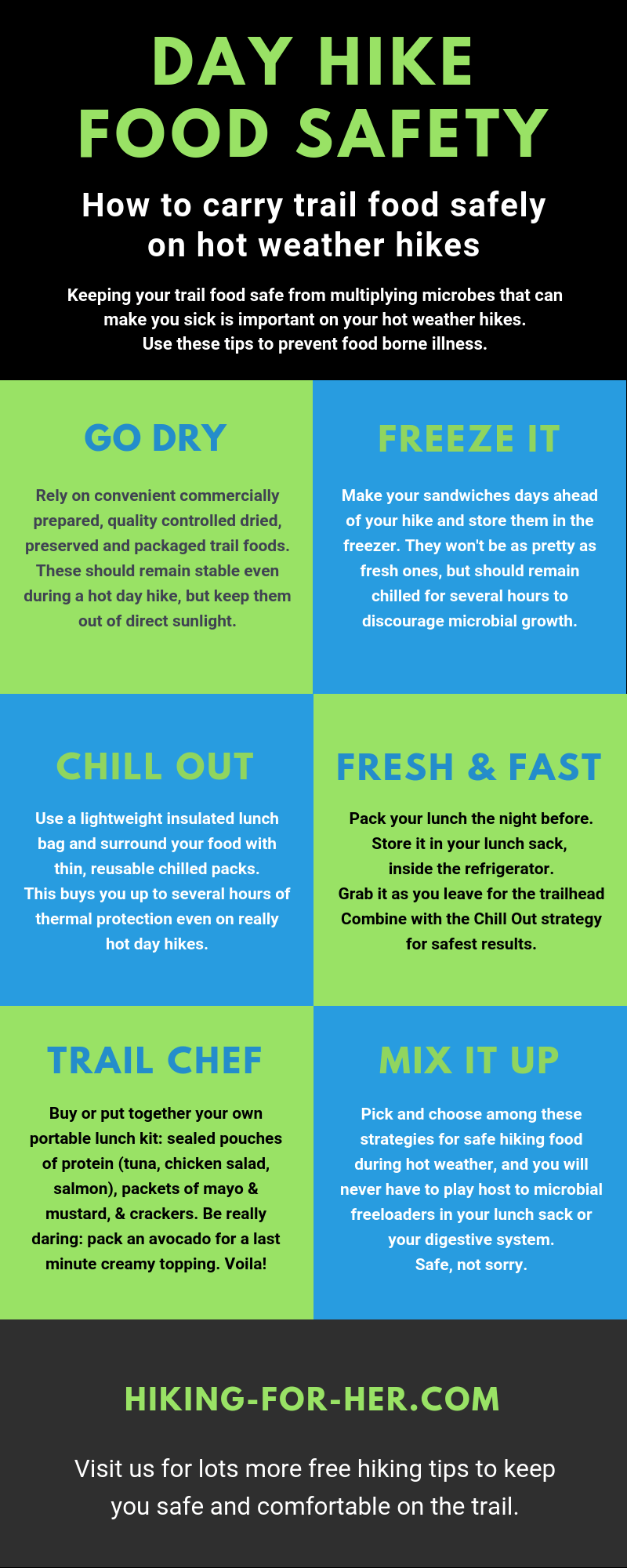
Dayhike Food Safety:
Tips For Keeping Food
Safe To Eat
By Diane Spicer
Dayhike food safety tips involve smart food preparation and technology to keep your hiking food at temperatures that prevent bacterial growth and spoilage.
No need to get into the microbiologic nitty gritty.
But there's a definite need to be smart about how to prepare, transport and consume your trail food on a long, hot day hike.
Let's begin.
Three philosophies about
dayhike food safety
Everyone needs to know how to pack a lunch for a warm day hike that won't end up creating digestive problems.
But there are three ways to approach the problem of food safety as a day hiker.
Let's see which one resonates with you.
Skip the fresh stuff
One line of thinking says go for convenience and a low risk of dayhike food safety issues:
- Eat only preserved, dried and dehydrated foods, as you see in the photo above.
Here's why:
If your non-refrigerated trail food is pre-packaged and prepared in commercial kitchens with high levels of safety and quality control, you can consume your lunch with a high degree of confidence that it won't make you sick on hot day hikes.
- Read my AlpenFuel review for an example of this type of day hike food approach.
- Here are the trail snacks I recommend, based on taste, convenience and nutrition.
Other food that will make good unchilled lunch fixings on a hot day hike:
- nut butter & fruit spread sandwiches
- firm, juicy food like apples, grapes, carrots, peppers, & jicama that you can drizzle with squeeze tubes of hummus or nut butters
- generous handfuls of nuts and dried fruit
Why not prep the food
right at your lunch spot?
You can find handy little lunch kits and make a delicious sandwich right before you consume it.
Then there's no need to wonder if the temperature was stable and appropriate during your trail time.
- For example, here's a chicken salad kit.
- Ham, tuna and other kits are easy to find, too.
Make your own ideas:
- A zip open pouch of tuna, a few squeeze packets of mayo and relish, an avocado that has been protected carefully from squashing inside your backpack, and your favorite bread slices can be combined into the perfect dayhike sandwich.
- Use your favorite crackers instead of bread for a protein rich lunch that replenishes your salts, too.
Third option:
enjoy fresh foods on the trail
You might be thinking about how enjoyable a deliciously thick sandwich piled high with tuna fish, avocado, and cheese tastes after a long morning on the trail.
But you don't want to pack all the ingredients & make it on the trail, you just want to bite into it when you're famished.
I'm right there with you!
But let's be smart about how to prepare and store that perishable food on your long, hot day hike.
Prepare your day hike food
to keep it safe on the trail
I'm going to throw a little science at you here.
It won't hurt, I promise. (You can always "duck" down to the tips using this link.)
Two important words for dayhike food safety:
- Clean
- Cold
At home, that's easy to do because you have easy access to soap, water and refrigeration.
On the trail? Not so much.
So it's doubly important to make sure your food is uncontaminated with microbes at home, and that you either freeze it before your hike, or store it in the refrigerator until you leave for your hike.
The U.S. government shares food safety tips for outdoor activities including dayhiking in these resources:
- Food Safety While Hiking, Camping & Boating (USDA)
- Why Chilling Food Is Important (gives the names of food pathogens, and more)
Trail tip
If your hiking plans require your hiking lunch to sit unrefrigerated two
hours or less before you eat it, you probably don't need to take extreme
precautions to keep it chilled once it's out of the freezer or frig.
Two caveats to that statement:
- This rule works for hiking in temperatures less than 90F.
- If you will be hiking in exposed terrain with the sun beating down on your backpack every minute of the hike (heating up your lunch inside), any temperature above 80F requires that you keep your food chilled after 1 hour of hiking.
What about freezing your trail food
ahead of time?
There are two dayhike food safety issues with freezing sandwiches and other trail food.
Let's tackle the more sinister one first.
- Microbes
Bacteria, mold and other microbes will go into suspended animation when they're frozen in your meats, cheeses and sandwich fillings.
As your food thaws in your lunch bag, they start multiplying. And they multiply fast, creating a new generation of trouble makers every 20 - 60 minutes.
- On a hot weather hike, the temperatures can be right for them to reach huge levels, setting you up for hiking food borne illness.
Now for the palatability (taste, texture) of frozen food that thaws as you hike.
Sliced meats and cheeses between bread slices will still look and taste pretty good if they've been frozen.
- In case you're wondering, there is not much decrease in the nutrient value of frozen food.
- And "freezer burned" food (stored for a long time and not wrapped properly) is safe to eat, but won't look palatable.
All bets are off for your sandwich enhancements such as mayonnaise, creamy dressing, eggs, avocado, lettuce and tomatoes. Can you say soggy mess three times fast?
 No shade in sight! Use these tips for safe hiking food in these conditions.
No shade in sight! Use these tips for safe hiking food in these conditions.
Dayhike food safety tips for
hot weather hiking
Here's the approach I use to keep my fresh foods chilled during hot weather day hiking.
I use a neoprene thermal insulated food bag, like this one, for these reasons:
- Super lightweight (7 oz) & more durable than a plastic bag
- Easy to keep clean - toss it in the washing machine
- Large enough for carrying a chilled lunch for two people, or food for a long hot day hike for one person
- Zippered top keeps everything locked down tight
- Not rigid, so will fit the contours of the gear around it inside my pack
- When empty, can be rolled up small and stuffed into an external pocket on my backpack
Read my Hydro Flask insulated food tote review for an example of a worthy 8 liter day hike lunch carrier.
The night before my hike, I make my sandwiches and other fresh treats, and pack up this food bag. Then I store the bag in the refrigerator, so it's nicely chilled when I grab it in the morning.
But I'm not done yet with my dayhike food safety approach!
Before I put the lunch bag into my pack, I insert two very thin freezer gel packs, one at the bottom of the sack and one on the side that will face toward the outside of the pack (most likely to have sun hitting it).
Keep it chill
These Coleman chill packs work great, because:
- they're lightweight,
- they are small and thin, so you can easily fit them inside the neoprene lunch bag,
- they're filled with a non-toxic ice "substitute" so you can re-use them multiple times,
- they don't drip like a home made ice pack will.
If you handle them gently, you'll be in business for a long time for a low cost.
If you pre-chill your entire lunch as recommended above, and add these little chill packs at the last possible minute before leaving for the trail head, they should keep your food chilled up to 4 hours.
- Probably less if the day is above 90F and your backpack is in direct sun, although I haven't tested this.
- Not because I don't want to, but because the high alpine Pacific NW hiking I do rarely puts me into that temperature range.
Word of caution
Don't just throw these into the freezer, because they will assume whatever shape they happen to land in.
- Lay them flat so they'll freeze flat and fit easily into your food bag.
Trail tip: Use these cold packs to cool down hot spots on your feet, legs and joints during, and after, your hike. Or just enjoy their cool sensation on your hot forehead as you hike along.
- By the time you eat lunch, they can be molded to fit beneath the brim of your hiking hat.
Don't want to use these bags?
I hear you! I also have some ideas for you:
- Use a bag of frozen grapes or blueberries instead. Enjoy popping them into your mouth as part of your hydration strategy on a hot trail, knowing they kept your lunch safely chilled.
- Freeze some fruit yogurt sticks (sealed and nicely portable) and insert them between your sandwiches as a food chilling strategy. Mighty tasty as a chilled dessert on the trail, and the calcium will be welcomed by your tired muscles.
For more dayhike food ideas, read this.
How to wrap and carry hiking food?
Lightweight plastic wrap works great for most day hike food.
But if it's extra juicy, use a snap lid plastic container, and put it into a sealable plastic bag as a precaution.
- You don't want food to leak and saturate your backpack with animal attracting odors.
- And sticky hiking gear and clothing is no fun, either.
One more step
in dayhike food safety
I take one final thermal precaution with my dayhike food safety approach:
- I wrap my extra clothing (part of my ten essentials) around the lunch sack.
- Then I bury my lunch sack deeply inside my backpack, with it midway between my soon-to-be hot, sweaty back and the sun exposed outer portion of the pack.
A bit of added thermal insulation never hurts, right?
Lunch time trail tip:
Use a moist hand wipe or a squirt of hand sanitizer before you handle your food.
It would suck if you went to all of the trouble to keep the food safe but swallowed microbes from your own dirty hands on the trail, wouldn't it?
Just in case...
food borne illness symptoms
Unbelievable as it may be, it's possible to show signs of food borne bacterial sickness within half an hour of consuming contaminated food.
Or it might be 1 to 3 days after you eat the food.
Regardless of the time span, these bacteria are not shy about letting you know they're in your gastrointestinal tract:
- Vomiting
- Diarrhea
- Abdominal cramping and distress
- Flu-ish pattern including fever, headache, and achy muscles
But you can avoid this whole scenario by utilizing these dayhike food safety tips.
So now you know!
If you've read this far, you know a lot of dayhike food safety precautions you can take for your next hot weather day hike.
- You'll never have to wonder again if you've taken the right precautions for your food.
And you know a bit of the science behind keeping trail food safe in hot conditions.
- Clean and chilled wins the race against the microbes.
For some tips on clean drinking water on the trail, read my Lifestraw Go water bottle/filter review here.
But if you have any questions, please feel free to use the Ask A Question link and I'll happily answer them.
Here's a quick recap:
More hot weather hiking tips for you
While it's important to keep your fresh food safe on a hot day hike, it's also a good idea to prepare your body and your hiking gear for high temperatures.
As they say at the USDA, chill out!
- These hot weather hiking tips will get you started.
Home page > Best Hiking Tips >
Dayhike Food Safety
|
I get emails all the time about what I wear, eat, carry and love to use on the trail. That's
why I provide affiliate links to you: the best gear that I use myself and have seen used by other hikers is instantly
available for your consideration, and the gear company sends a few
pennies per dollar to this reader-supported hiking website. There is no added cost to you! Everyone ends up a winner: Great gear for you, strong gear companies, and more free hiking tips for everyone. Thanks very much for your support. It's warmly and sincerely appreciated. It also helps send these hiking tips to all your virtual trail buddies around the globe. |
 |





